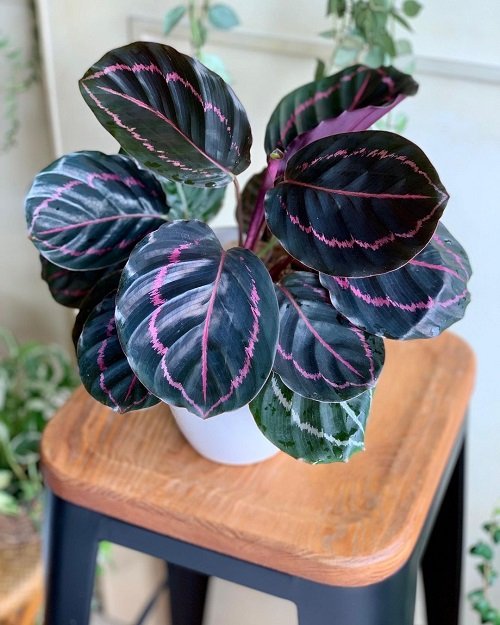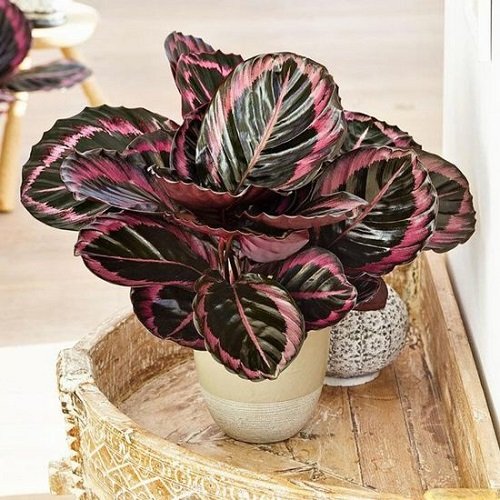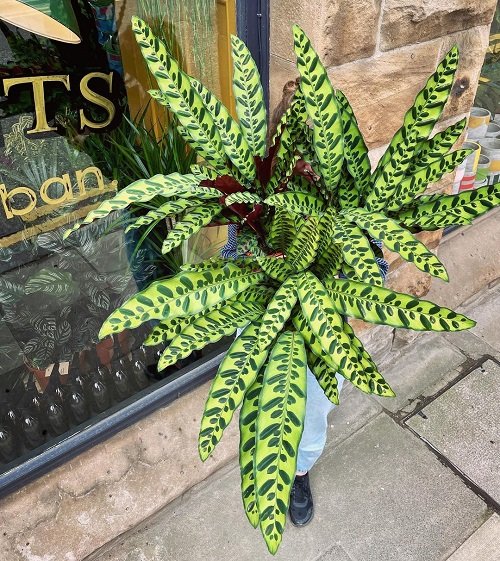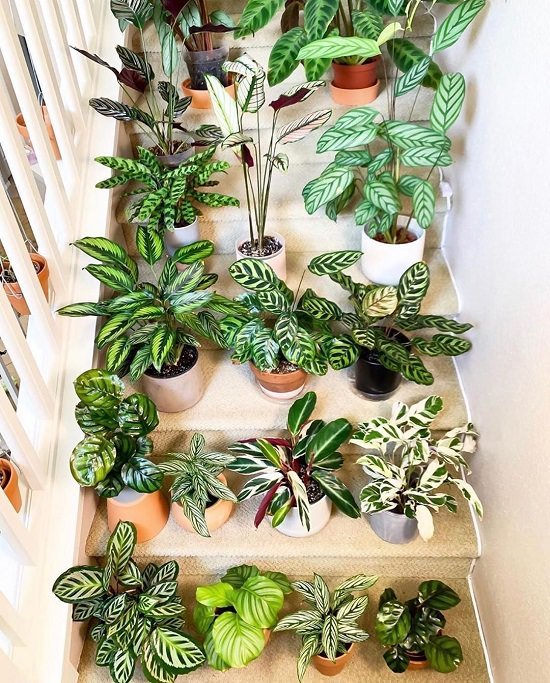Want to learn the secrets to Calathea Care to ensure their stunning foliage stays attractive? We’ve got you covered.

Don’t know the right Calathea Care? When it comes to maintenance, this tropical plant can be a bit fussy about temperature, light, and humidity requirements. But read on, and soon you’ll be an expert on the care of Calathea plant.
Check out our article on watermelon peperomia care here!
Calathea Plant Information
The Calathea plant is native to the tropical regions of Central and South America. It belongs to the Marantaceae family, which includes various other colorful and patterned plants. Calathea plants are commonly found in rainforests, where they thrive under the shade of larger trees.
These plants are famous for their eye-catching leaves with intricate patterns and vibrant colors. The leaves grow on long stems, and their distinct feature is their ability to open and close in response to the changing light – they “dance” during the day and fold up at night.
Calathea plants come in a variety of species and cultivars, each with its own distinctive traits, and overall, Calathea care can be challenging if you’re growing it for the first time. Some popular varieties include the Calathea ornata, with its pink stripes, and the Calathea picturata, with its dark-purple leaves and prominent pink markings.
Here are some of the best varieties of calathea that you can grow!
How to Grow Calathea
There are many ways to grow Calathea via seeds, cuttings, etc. However, Calathea is primarily propagated through division, where established plants are divided into smaller sections, each with roots and foliage.
This is the most successful method for maintaining the unique characteristics of the parent plant. Here is how you can grow Calathea via division:
- Gather a sharp, clean knife or gardening shears and a clean container with well-draining soil.
- Water the Calathea a day before division to ensure it’s well-hydrated and easier to work with.
- Gently remove the entire plant from its pot and shake off excess soil to expose the root system.
- Carefully separate the plant into smaller sections, ensuring each section has healthy roots and several leaves.
- Trim any damaged or rotting roots, and trim large leaves to reduce stress on the divided plant.
- Plant each division in its own clean container with well-draining soil. Make a small hole, place the division inside, and gently pat the soil around it.
- Water the newly potted divisions thoroughly and place them in a humid environment or cover them with a plastic bag to retain moisture.
- Place the containers in an area with bright, indirect light. Avoid direct sunlight, which can scorch the leaves.
- Keep an eye on the divisions for a few weeks, ensuring proper Calathea care. Mist the leaves regularly to maintain humidity.
After a few months, when the divisions have established roots and new growth, you can consider transplanting Calethea in a pot if needed.
Note: Spring or early summer is the best time for division when the plant is actively growing.
Best Pot for Growing Calathea

Wondering what size pot for Calathea? Choosing the right Calathea pot size is crucial for the right Calathea care and growth. For divisions, it’s recommended to select pots that are slightly larger than the root system to allow room for growth. A pot with a diameter of around 5-6 inches (12-15 cm) is suitable for newly divided Calathea sections.
As Calathea plants mature and grow larger, it’s advisable to opt for pots with a diameter of 8-10 inches (20-25 cm) or slightly larger. A larger Calathea plant pot size accommodates the plant’s expanding root system and prevents becoming root-bound. However, it’s essential to avoid choosing a pot that is excessively large, as this can lead to over-watering and slower growth.
Don’t know how to choose the best type of pot for Calathea? Pick any that you like. Just ensure the chosen pot has drainage holes to prevent waterlogging, which can harm the plant’s health.
Here are Plant Pot Sizes from Inches to Gallon
Best Time to Plant Calathea
The best time for planting Calathea is during the spring and early summer months. This period aligns with the plant’s natural growth cycle and ensures optimal conditions for successful cultivation.
As temperatures begin to rise and daylight hours increase, Calathea plants become more active, showing robust growth and renewed vitality. Planting or propagating Calathea during this time allows them to establish their roots and acclimate to their new environment before the colder months or potential periods of dormancy.
Requirements for Growing Calathea
Sunlight
Don’t know about Calathea care? We’ve got you covered. This beautiful plant is not fussy about the light requirements and thrives well even in low light. Calathea performs poorly in the direct sun as it bleaches out the leaves.
Place your plant near a location where it’ll receive bright indirect sunlight.
Soil
Calathea plants prefer well-draining and slightly acidic soil for optimal growth. A mixture that combines regular potting soil with peat moss, coconut coir, and perlite helps create the right balance of moisture retention and aeration.
The soil should have a pH level of around 6.0 to 6.5. This composition supports Calathea’s root health and prevents waterlogging, which can lead to root rot.
Here is one recipe:
Ingredients:
Peat or Coco Coir: Both are good at retaining moisture. Coco coir is a sustainable alternative to peat moss.
Perlite or Pumice: These provide good aeration and ensure the mix is well-draining.
Orchid Bark or Pine Bark: These help with aeration and can also add a slight acidity to the mix.
Worm Castings or Compost: These provide essential nutrients for the plant. (Optional, but recommended for added nutrition)
Recipe:
- 2 parts peat or coco coir
- 1 part perlite or pumice
- 1 part orchid bark or pine bark
- 0.5 parts worm castings or compost (if using)
Steps:
- Pre-wet the Coco Coir or Peat: Especially if using peat moss, it’s good to wet it first since it can initially repel water. This ensures that the mix is uniformly moist.
- Mix Ingredients: Combine the peat or coco coir, perlite or pumice, orchid bark, and worm castings or compost in a large bucket or container. Use your hands or a trowel to mix everything together thoroughly.
- Check Consistency: The mix should be light and fluffy. When you squeeze a handful, it should hold together but crumble apart easily without being too soggy.
- Pot Your Calathea: Make sure to water the plant thoroughly after repotting.
Water
For calathea care indoors, you have to be a little careful as these plants are sensitive to the water used. Avoid using hard water. Using distilled or filtered water is best. Or, let the tap water sit overnight before using it to water the plants.
Always keep the soil dry and never overwater. Allow 2-3 inches of the topsoil to go dry before watering again.
Temperature and Humidity
Calathea plants thrive in a warm and consistent environment, ideally maintaining temperatures between 65°F to 80°F (18°C to 27°C).
Calathea performs well at a relative humidity level of 50 percent or more. Place the pot in a tray filled with water and pebbles, or use a humidifier. Grouping the plants also helps in increasing the humidity.
Note: It’s important to avoid sudden temperature fluctuations or exposure to cold drafts, as these can stress the plant and lead to leaf damage. Keeping the temperature within the above range ensures the Calathea’s vibrant foliage and growth, allowing it to flourish and exhibit its characteristic beauty.
Calathea Care
Don’t know how to care for a calathea? Don’t worry. Read on, and you will learn all the dos and don’ts of Calathea plant care indoors.
Fertilizer
Feed your Calathea using your regular balanced liquid fertilizer you use for other houseplants. Check out in details below:
Temperate Regions (Cold Winters):
Spring & Summer: This is the primary growing season. Monthly fertilization, diluted to half the recommended strength, supports the plant’s active growth phase.
Autumn & Winter: Growth slows down due to decreased light and temperatures. Reduce fertilizer application or cease entirely to avoid over-nourishing.
Tropical and Equatorial Regions (Consistently Warm):
Year-Round: In consistently warm climates, Calatheas may continue to grow throughout the year. You can fertilize them lightly but regularly, possibly every 6-8 weeks, always observing the plant for signs of over or under-fertilizing.
Hot Regions (Hot Days, Cooler Nights, USDA Zones 10 and above):
Winter & Spring: These are the more suitable growing periods when temperatures are milder. Fertilize lightly during these months.
Summer: Extremely high temperatures and sunlight may stress the plant. Reduce fertilizing, and if the plant seems stressed, hold off completely.
Regardless of the climate, it’s essential to always observe your Calathea. If its leaves become pale, it might need more nutrients. Conversely, brown or crispy leaf edges might indicate over-fertilization or the need to switch to distilled or rainwater due to water quality issues. Adjustments based on your plant’s specific responses are always crucial.
Pruning
Prune your Calathea by trimming away any yellow or brown leaves at their base is crucial for Calathea care. Regularly removing these damaged leaves helps the plant focus its energy on healthy growth.
If your plant becomes too leggy, you can trim back the stems to encourage bushier growth and maintain proper and healthy Calathea size. Use clean, sharp scissors or pruning shears for a clean cut.
Pests and Diseases
Calathea plants can be susceptible to pests like spider mites and mealybugs. Keep an eye out for any signs of these pests, such as webbing or tiny white cotton-like spots, and treat them promptly. To prevent pests, regularly wipe the leaves with a damp cloth and keep the plant’s surroundings clean. Make this a part of your Calathea care routine.
Calathea can also face issues like leaf spots due to excessive moisture or fungal infections. Ensure good air circulation and avoid overwatering to prevent such problems. If you notice any issues, remove affected leaves and adjust your care routine accordingly.
Here’s everything you need to know about Haworthia care!
FAQs
1. What Are the Essential Calathea Care Instructions for Indoor Cultivation?
For indoor Calathea care, place the plant in bright, indirect light, away from direct sunlight. Keep the soil consistently moist but not waterlogged, allowing the top inch to dry before watering again.
Fertilize your Calathea indoors once a month during the growing season and ensure optimum temperature range.
2. How Can I Ensure Successful Calathea Care Indoors?
To ensure successful Calathea indoor care, choose a well-draining potting mix and a container with drainage holes. Rotate the plant occasionally to promote even growth and prevent leaning.
Avoid placing the plant near cold drafts or heaters, which can stress the plant.
3. Can I Revive a Wilting Calathea Plant, and How?
If your Calathea is wilting, it might be due to underwatering, overwatering, or improper lighting. First, check the soil moisture – if dry, water thoroughly, but if it’s soggy, let it dry out. Adjust watering frequency to prevent extremes.
Ensure the plant receives indirect light and isn’t exposed to cold drafts. Trim any severely damaged leaves and give the plant time to recover properly.




